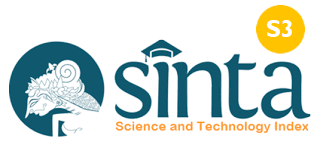Student Interest In Learning Reading Comprehension Of Expository Text Toward Mind Mapping Technique
Abstract
Penelitian ini bertujuan untuk mengetahui minat siswa dalam belajar membaca pemahaman teks ekspositori terhadap teknik Mind Mapping. Penelitian ini menggunakan pendekatan kuantitatif dengan menggunakan desain survei. Peneliti melakukan penelitian ini di kelas XI SMA Negeri 8 Takalar tahun 2017/2018. Populasi penelitian ini yang terdiri dari enam kelas dengan jumlah populasi 93 siswa. Karena jumlah populasi besar, peneliti menggunakan teknik cluster random sampling. Jumlah sampel penelitian ini adalah 32 siswa. Untuk menganalisis tes hasil dan kuesioner, peneliti menggunakan analisis teknik persentase. Penggunaan teknik analisis persentase adalah untuk melihat persentase minat siswa dengan menggunakan teknik Mind Mapping. Untuk memvalidasi kuesioner minat dan untuk mengetahui skor rata-rata, standar deviasi dan persentase minat siswa, peneliti menggunakan program SPSS 17.0.
Hasil penelitian ini adalah penggunaan teknik Mind Mapping dalam pengajaran membaca pemahaman sangat menarik, hal ini menunjukkan bahwa 29 siswa (90,63%) merasa sangat positif, 3 siswa (9,37%) siswa merasa positif, dan tidak ada siswa. merasa netral, negatif dan sangat negatif. Nilai rata-rata minat siswa teknik Mind Mapping dalam pengajaran dan pembelajaran pemahaman membaca adalah 89,56 yang dikategorikan sebagai minat yang sangat tinggi. Persentase minat siswa dalam membaca pemahaman teks ekspositori terhadap teknik Mind Mapping adalah 90,63 (kategori sangat tinggi).
References
Batunan, Deisyi Anna. 2010. Instructional Materials for Narrative, Descriptive, and Expository Essays at the English Department of UniversitasNegeri Manado. Unpublished Thesis. Graduate Program of UniversitasNegeri Malang.
Brown, Douglas H. 1994. Principles of Language Learning and Teaching. United States of America: Prentice Hall Regents.
Brown, Chance. 2008. Best Definition of Mindmapping I’ve Ever Read. Retrieved on 13th June 2018 from http://mindmapblog.com/?p=480.
Budd, J. W. 2003. Mind Maps as Classroom Exercises. Minnesota: University of Minnesota.
Buzan, T. 1991. The Mind Map Book. New York: Penguin.
Buzan, T., & Buzan, B. (2000). The Mind Map Book. London: BBC Books.
Buzan, T.2005. The Ultimate Book of Mind Maps.British: Thorsons.
Carillo W. Lawrence. 1976. Teaching Reading: A Handbook. United States of America: St. Martin’s Press, Inc.
Crane, Tim. 2001. Elements of Mind: An Introduction to the Philosophy of Mind. New York: Oxford University Press. (CD-ROM InfoTrac.2001).
Faste, Rolf. 1997. Mind Mapping. Retrieved on March 22nd. 2018 From http://www.fastefoundation.org/publications/mind_mapping.pdf
Good, G.E., & Wood, P.K. 1995. (5), Effects of Relaxation and Music on Postoperative of Advanced nursing, 24 (5), 905-914
Gordon, Christine J. 2008. Modeling an Expository Text Structure Strategy in Think Alouds. Retrieved on March 22nd. 2018 From http://scholarworks.wmich.edu/cgi/viewcontent.cgi?article=1608&context=reading_horizons.
Harmer, Jeremy. 1991. The Practice of English Language Teaching. United States of American: Longman.
Hikmat, Ade and Solihati, Nani. 2013. Bahasa Indonesia (untuk Mahasiswa S1 &Pascasarjana, Guru, Dosen, Praktisi, dan Umum). Jakarta. Kompas Gramedia.
Johnson, Keith and Morrow, Keith. 1987. Communication in the Classroom: Applications and Methods for a Communicative Approach. Great Britain: Longman.
Kustaryo, S. 1988. Reading Technique for Colleague Students. Jakarta: Proyek Pengembangan Lembaga Pendidikan Tenaga Kependidikan, Direktorat Jenderal PendidikanTinggi, Depdikbud.
Masuhara, Hitomi. 2003. “Material for Developing Reading Skill” in Tomlinson (Ed), Developing Material for Language Teaching. New York. Continuum.
Moss, Barbara. 2004. Teaching Expository Text Structures Through Information Trade Book Retellings. Retrieved on March 8th, 2017. From http://www.rebeltutor.literacydevelopment.org/Nonfiction%20Text/teaching%20expository%20text%20structures.pdf.
Murley, D.2007. Mind Mapping Complex Information. Illinois: Southern Illinois University School of Law Library.
Nur Asia. 2008. Using Cooperative Script Technique to Increase Reading Comprehension at the Second Years Students. Unpublished Thesis. UIN Alauddin Makassar.
Pang, Elizabeth S, Et al. 2003. Teaching Reading. International Bureau of Education. Retrieved on August 14th, 2017. From http://d.scribd.com/ docs/24hzkyp20umdez4plla.pdf.
Richard Jack, Platt, John and Weber, Heidi. 1985. Longman Dictionary of Applied Linguistics. Essex :Longman Group Limited.
Rivers, W.M. 1981. Teaching Foreign Language Skills. Chicago: The University Chicago Press.
Rivers, W.M., &Temperley, M.S. 1978. A Practical Guide to the Teaching of English as a Second or Foreign Language. Oxford: Oxford University Press.
Schiefele, U. 1999. Interest and Learning from Text. Scientific Studies of Reading, 3(3), 257-279.
Sugiono. 2012. Statistika untuk Penelitian. Bandung: Alfabeta CV.
Susilawaty. 2010. Using the Smart Technique to Improve the Reading Comprehension of the Second Semester Students of Unismuh Palu. Unpublished Thesis. Graduate Program of Universitas Negeri Malang.
Thinker, A. Miles and Cullogh, M.McCinstance. 1975. Teaching Elementary Reading. New Jersey: Practice-Hall Inc. English Clifts.
Downloads
Published
How to Cite
Issue
Section
License
An author who publishes in the Cetta : Jurnal Ilmu Pendidikan agrees to the following terms:
- Author retains the copyright and grants the journal the right of first publication of the work simultaneously licensed under the Creative Commons Attribution-ShareAlike 4.0 License that allows others to share the work with an acknowledgement of the work's authorship and initial publication in this journal
- Author is able to enter into separate, additional contractual arrangements for the non-exclusive distribution of the journal's published version of the work (e.g., post it to an institutional repository or publish it in a book) with the acknowledgement of its initial publication in this journal.
- Author is permitted and encouraged to post his/her work online (e.g., in institutional repositories or on their website) prior to and during the submission process, as it can lead to productive exchanges, as well as earlier and greater citation of the published work (See The Effect of Open Access).
Read more about the Creative Commons Attribution-ShareAlike 4.0 Licence here: https://creativecommons.org/licenses/by-sa/4.0/.





